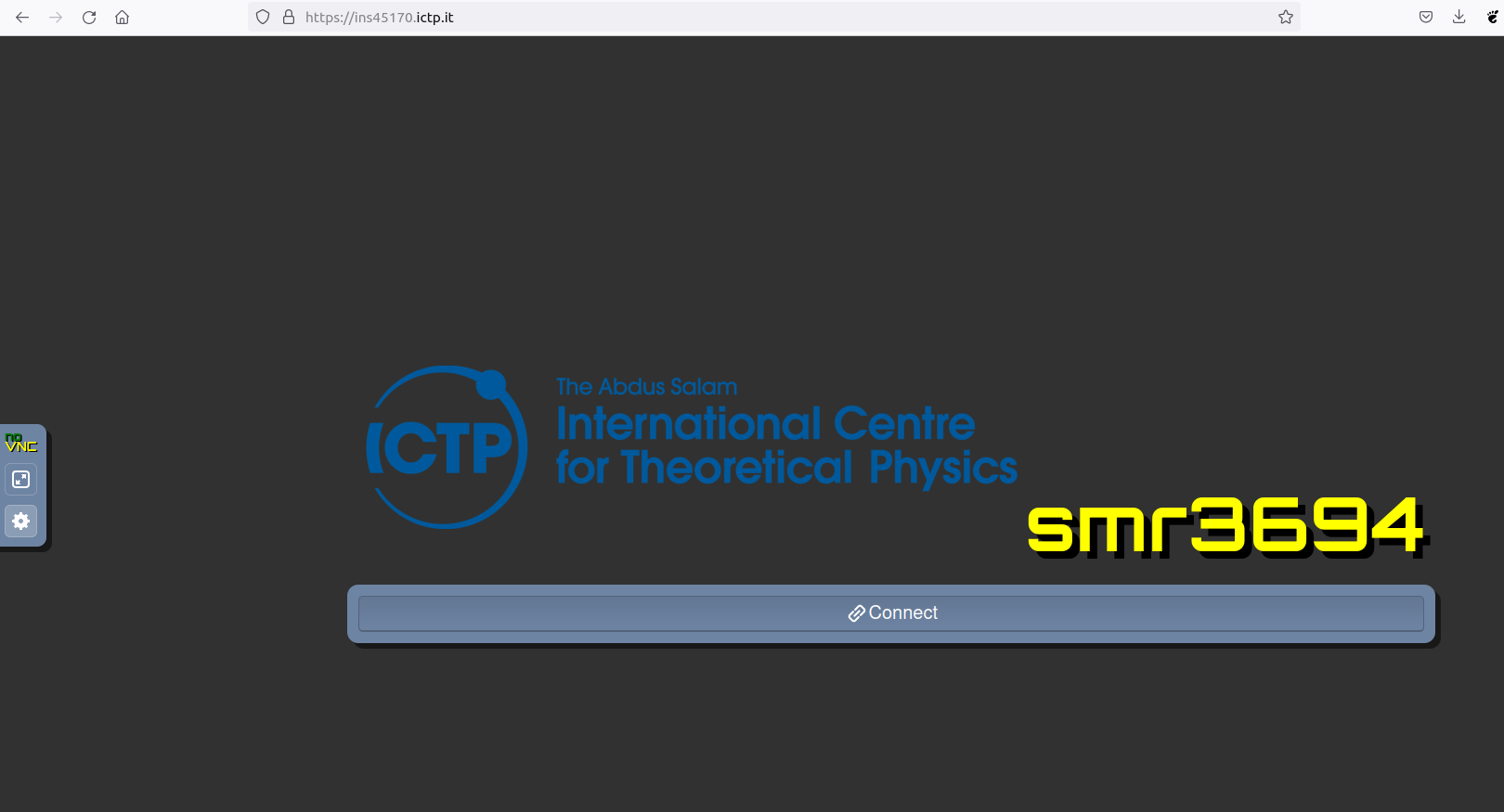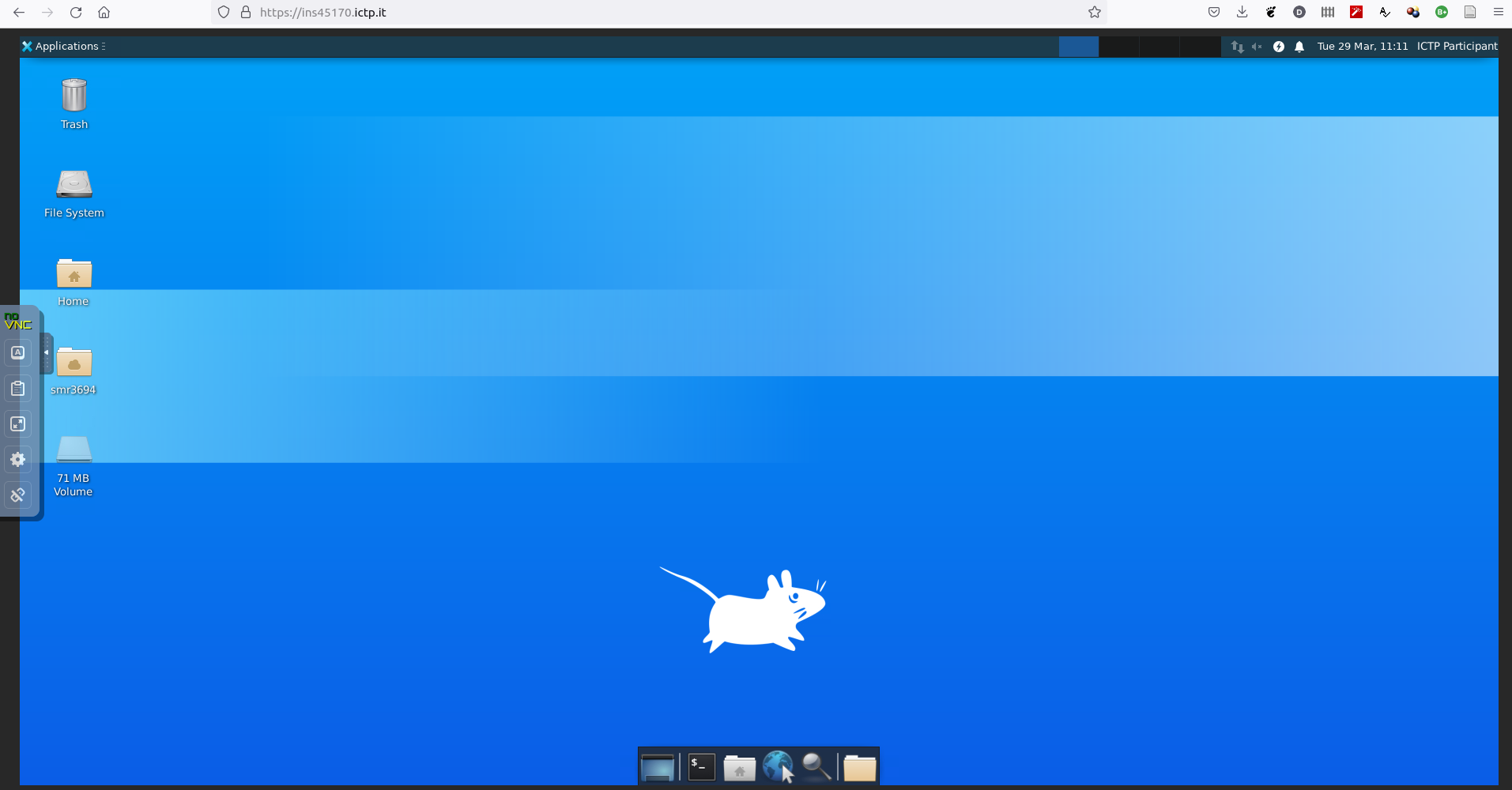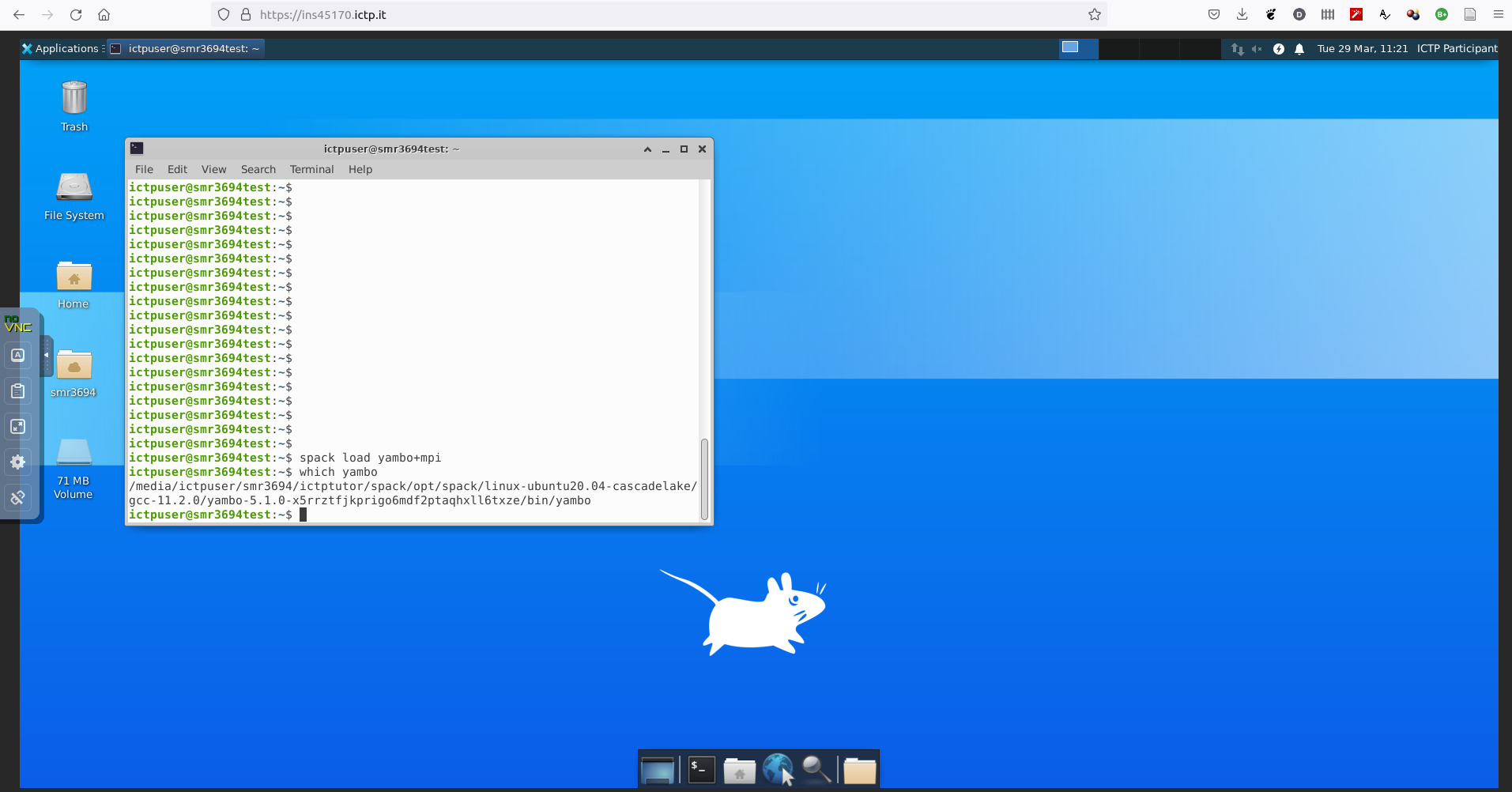ICTP cloud: Difference between revisions
(Created page with "A the participants of the computational school on "Ab-initio Many-body Methods and Simulations with the Yambo Code" will be sent a link and a password to connect via noVNC to a Virtual Machine running on the ICTP cloud server. This is the strongly suggested mode to work on the hand-on sessions. noVNC is a open source VNC (Virtual Network Computing, a graphical desktop-sharing system) client that runs well in any modern browser. == How to connect == - Click on the link...") |
No edit summary |
||
| (30 intermediate revisions by 2 users not shown) | |||
| Line 1: | Line 1: | ||
In the case of Yambo activities sponsored by [https://www.ictp.it// ICTP] all the participants will receive a link and a password to connect via noVNC to a Virtual Machine running on the ICTP cloud server. | |||
noVNC is a open source VNC (Virtual Network Computing, a graphical desktop-sharing system) client that runs well in any modern browser. | noVNC is a open source VNC (Virtual Network Computing, a graphical desktop-sharing system) client that runs well in any modern browser. | ||
== How to connect == | == How to connect == | ||
* Click on the link that you received by the school organizers or copy and paste it in the url bar of your favorite browser. | |||
[[File:ICTP Virtual machine.png|600px|Yambo tutorial image]] | |||
* Click on the connect button and insert the password. | |||
Your browser will become a linux desktop | |||
[[File:ICTP Virtual machine on.png|600px|Yambo tutorial image]] | |||
== How to load the Yambo code and the tutorials == | |||
(i) Open a terminal (click on the black terminal icon, the second from the left in the lower part of the screen) and load the yambo code via spack: | |||
spack load yambo | |||
[[File:ICTP Virtual machine terminal.png|600px|Yambo tutorial image]] | |||
(ii) The Yambo tutorial material is available for the copy from this path: | |||
cp -r /media/ictpuser/smr3694/ictptutor/YAMBO_TUTORIALS ~/ | |||
(iii) One of the tutorial shows the usage of Yambopy, it is installed via Anaconda. Yambopy is used both to manage workflows and to do postprocessing. So, in order to use it you have to load three spack pakages: | |||
spack load quantum-espresso | |||
spack load yambo | |||
spack load anaconda3 | |||
NB: load the anaconda3 package only for the yambopy tutorial, otherwise you may run into problems with gnuplot. | |||
(iv) The Yambopy tutorial material is available for the copy from this path: | |||
cp -r /media/ictpuser/smr3694/ictptutor/YAMBOPY_TUTORIALS ~/ | |||
== Other useful spack commands == | |||
In the virtual machine Yambo was installed via the Spack tool. Spack is a package manager for supercomputers, Linux, and macOS. It makes installing scientific software easy. | |||
spack find [options] [package] | |||
List and search installed packages. | |||
Useful options can be: | |||
-p: show paths to package install directories | |||
-v: show variants in output (can be long) | |||
An example: | |||
ictpuser@smr3694test:~$ spack find -v yambo | |||
==> 1 installed package | |||
-- linux-ubuntu20.04-cascadelake / gcc@11.2.0 ------------------- | |||
yambo@5.1.0~cuda~dp+mpi+openmp~parallel_io+ph+rt~yambopy cuda_arch=none linalg=slepc | |||
patches=b9362020b0a29abec535afd7d782b8bb643678fe9215815ca8dc9e4941cb169f,e3dcb3df39e2c70ebd57ded322d4ddbc1e23bf3b521541d29d4ea0377c475059 profile=memory,time | |||
Variants are the way Spack calls the packages' installation options. The command used to have info about a package and its variants is: | |||
spack info <package> | |||
An example: | |||
ictpuser@smr3694test:~$ spack info yambo | |||
AutotoolsPackage: yambo | |||
Description: | |||
YAMBO is an open-source code released within the GPL licence. YAMBO | |||
implements Many-Body Perturbation Theory (MBPT) methods (such as GW and | |||
BSE) and Time-Dependent Density Functional Theory (TDDFT), which allows | |||
for accurate prediction of fundamental properties as band gaps of | |||
semiconductors, band alignments, defect quasi-particle energies, optics | |||
and out-of-equilibrium properties of materials. The code resorts to | |||
previously computed electronic structure, usually at the Density | |||
Functional Theory (DFT) level and for this reason it is interfaced with | |||
two of the most used planewave DFT codes used in scientific community, | |||
Quantum ESPRESSO and Abinit. | |||
Homepage: http://www.yambo-code.org/index.php | |||
Maintainers: @nicspalla | |||
Externally Detectable: | |||
False | |||
Tags: | |||
None | |||
Preferred version: | |||
5.1.0 [git] https://github.com/yambo-code/yambo.git on branch master | |||
Safe versions: | |||
5.1.0 [git] https://github.com/yambo-code/yambo.git on branch master | |||
5.0.4 https://github.com/yambo-code/yambo/archive/5.0.4.tar.gz | |||
5.0.3 https://github.com/yambo-code/yambo/archive/5.0.3.tar.gz | |||
5.0.2 https://github.com/yambo-code/yambo/archive/5.0.2.tar.gz | |||
5.0.1 https://github.com/yambo-code/yambo/archive/5.0.1.tar.gz | |||
5.0.0 https://github.com/yambo-code/yambo/archive/5.0.0.tar.gz | |||
4.5.3 https://github.com/yambo-code/yambo/archive/4.5.3.tar.gz | |||
4.5.2 https://github.com/yambo-code/yambo/archive/4.5.2.tar.gz | |||
4.5.1 https://github.com/yambo-code/yambo/archive/4.5.1.tar.gz | |||
4.5.0 https://github.com/yambo-code/yambo/archive/4.5.0.tar.gz | |||
4.4.1 https://github.com/yambo-code/yambo/archive/4.4.1.tar.gz | |||
4.3.3 https://github.com/yambo-code/yambo/archive/4.3.3.tar.gz | |||
Deprecated versions: | |||
None | |||
Variants: | |||
Name [Default] When Allowed values Description | |||
================= ============= ==================== ========================================================================= | |||
cuda [off] -- on, off Build with CUDA | |||
cuda_arch [none] -- none, 75, 70, 35, CUDA architecture | |||
86, 72, 60, 21, 10, | |||
80, 13, 53, 20, 62, | |||
32, 30, 11, 61, 52, | |||
37, 50, 12 | |||
dp [off] -- on, off Enable double precision | |||
linalg [none] -- none, parallel, Activate additional support for linear algebra: | |||
slepc "parallel" uses SCALAPACK and "slepc" is used for diagonalization of BSE | |||
mpi [on] -- on, off Enable MPI support | |||
openmp [off] -- on, off Enable OpenMP support | |||
parallel_io [off] @4.4.0:+mpi on, off Activate the HDF5 parallel I/O | |||
ph [off] -- on, off Compile PH executables | |||
profile [none] -- none, time, memory Activate profiling of specific sections | |||
rt [off] -- on, off Compile RT executables | |||
yambopy [off] -- on, off Install Yambopy package | |||
Installation Phases: | |||
autoreconf configure build install | |||
Build Dependencies: | |||
blas cuda fftw-api gnuconfig hdf5 lapack libxc mpi netcdf-c netcdf-fortran netlib-lapack openmpi petsc py-yambopy scalapack slepc | |||
Link Dependencies: | |||
blas cuda fftw-api hdf5 lapack libxc mpi netcdf-c netcdf-fortran netlib-lapack openmpi petsc py-yambopy scalapack slepc | |||
Run Dependencies: | |||
None | |||
Virtual Packages: | |||
None | |||
== How to retrieve data == | |||
=== On the Virtual Machine === | |||
First of all, it is a good idea to compact the data you want to download. So open a terminal inside the VM and pack the tutorial directories using the '''tar''' command: | |||
tar zcvf yambo_tutorials.tgz YAMBO* | |||
or using the '''zip''' command (you need to install it before): | |||
sudo apt update && sudo apt install zip | |||
zip -r yambo_tutorials.zip YAMBO* | |||
== | === On your laptop/workstation === | ||
If you are a Windows user I'm assuming that you installed OpenSSH as suggested in the document you received to obtain the VM credentials. Open a terminal (or cmd) in your laptop/workstation and copy the compressed package created in the VM. Remember to use the '''ssh key''' provided when you asked for the VM credentials and replace "ins45170.ictp.it" with the URL of your VM: | |||
- | scp -i SMR3694 ictpuser@ins45170.ictp.it:yambo_tutorials.tgz . | ||
or | |||
scp -i SMR3694 ictpuser@ins45170.ictp.it:yambo_tutorials.zip . | |||
Latest revision as of 10:15, 13 April 2022
In the case of Yambo activities sponsored by ICTP all the participants will receive a link and a password to connect via noVNC to a Virtual Machine running on the ICTP cloud server.
noVNC is a open source VNC (Virtual Network Computing, a graphical desktop-sharing system) client that runs well in any modern browser.
How to connect
- Click on the link that you received by the school organizers or copy and paste it in the url bar of your favorite browser.
- Click on the connect button and insert the password.
Your browser will become a linux desktop
How to load the Yambo code and the tutorials
(i) Open a terminal (click on the black terminal icon, the second from the left in the lower part of the screen) and load the yambo code via spack:
spack load yambo
(ii) The Yambo tutorial material is available for the copy from this path:
cp -r /media/ictpuser/smr3694/ictptutor/YAMBO_TUTORIALS ~/
(iii) One of the tutorial shows the usage of Yambopy, it is installed via Anaconda. Yambopy is used both to manage workflows and to do postprocessing. So, in order to use it you have to load three spack pakages:
spack load quantum-espresso spack load yambo spack load anaconda3
NB: load the anaconda3 package only for the yambopy tutorial, otherwise you may run into problems with gnuplot.
(iv) The Yambopy tutorial material is available for the copy from this path:
cp -r /media/ictpuser/smr3694/ictptutor/YAMBOPY_TUTORIALS ~/
Other useful spack commands
In the virtual machine Yambo was installed via the Spack tool. Spack is a package manager for supercomputers, Linux, and macOS. It makes installing scientific software easy.
spack find [options] [package]
List and search installed packages.
Useful options can be:
-p: show paths to package install directories -v: show variants in output (can be long)
An example:
ictpuser@smr3694test:~$ spack find -v yambo ==> 1 installed package -- linux-ubuntu20.04-cascadelake / gcc@11.2.0 ------------------- yambo@5.1.0~cuda~dp+mpi+openmp~parallel_io+ph+rt~yambopy cuda_arch=none linalg=slepc patches=b9362020b0a29abec535afd7d782b8bb643678fe9215815ca8dc9e4941cb169f,e3dcb3df39e2c70ebd57ded322d4ddbc1e23bf3b521541d29d4ea0377c475059 profile=memory,time
Variants are the way Spack calls the packages' installation options. The command used to have info about a package and its variants is:
spack info <package>
An example:
ictpuser@smr3694test:~$ spack info yambo AutotoolsPackage: yambo Description: YAMBO is an open-source code released within the GPL licence. YAMBO implements Many-Body Perturbation Theory (MBPT) methods (such as GW and BSE) and Time-Dependent Density Functional Theory (TDDFT), which allows for accurate prediction of fundamental properties as band gaps of semiconductors, band alignments, defect quasi-particle energies, optics and out-of-equilibrium properties of materials. The code resorts to previously computed electronic structure, usually at the Density Functional Theory (DFT) level and for this reason it is interfaced with two of the most used planewave DFT codes used in scientific community, Quantum ESPRESSO and Abinit. Homepage: http://www.yambo-code.org/index.php Maintainers: @nicspalla Externally Detectable: False Tags: None Preferred version: 5.1.0 [git] https://github.com/yambo-code/yambo.git on branch master Safe versions: 5.1.0 [git] https://github.com/yambo-code/yambo.git on branch master 5.0.4 https://github.com/yambo-code/yambo/archive/5.0.4.tar.gz 5.0.3 https://github.com/yambo-code/yambo/archive/5.0.3.tar.gz 5.0.2 https://github.com/yambo-code/yambo/archive/5.0.2.tar.gz 5.0.1 https://github.com/yambo-code/yambo/archive/5.0.1.tar.gz 5.0.0 https://github.com/yambo-code/yambo/archive/5.0.0.tar.gz 4.5.3 https://github.com/yambo-code/yambo/archive/4.5.3.tar.gz 4.5.2 https://github.com/yambo-code/yambo/archive/4.5.2.tar.gz 4.5.1 https://github.com/yambo-code/yambo/archive/4.5.1.tar.gz 4.5.0 https://github.com/yambo-code/yambo/archive/4.5.0.tar.gz 4.4.1 https://github.com/yambo-code/yambo/archive/4.4.1.tar.gz 4.3.3 https://github.com/yambo-code/yambo/archive/4.3.3.tar.gz Deprecated versions: None Variants: Name [Default] When Allowed values Description ================= ============= ==================== ========================================================================= cuda [off] -- on, off Build with CUDA cuda_arch [none] -- none, 75, 70, 35, CUDA architecture 86, 72, 60, 21, 10, 80, 13, 53, 20, 62, 32, 30, 11, 61, 52, 37, 50, 12 dp [off] -- on, off Enable double precision linalg [none] -- none, parallel, Activate additional support for linear algebra: slepc "parallel" uses SCALAPACK and "slepc" is used for diagonalization of BSE mpi [on] -- on, off Enable MPI support openmp [off] -- on, off Enable OpenMP support parallel_io [off] @4.4.0:+mpi on, off Activate the HDF5 parallel I/O ph [off] -- on, off Compile PH executables profile [none] -- none, time, memory Activate profiling of specific sections rt [off] -- on, off Compile RT executables yambopy [off] -- on, off Install Yambopy package Installation Phases: autoreconf configure build install Build Dependencies: blas cuda fftw-api gnuconfig hdf5 lapack libxc mpi netcdf-c netcdf-fortran netlib-lapack openmpi petsc py-yambopy scalapack slepc Link Dependencies: blas cuda fftw-api hdf5 lapack libxc mpi netcdf-c netcdf-fortran netlib-lapack openmpi petsc py-yambopy scalapack slepc Run Dependencies: None Virtual Packages: None
How to retrieve data
On the Virtual Machine
First of all, it is a good idea to compact the data you want to download. So open a terminal inside the VM and pack the tutorial directories using the tar command:
tar zcvf yambo_tutorials.tgz YAMBO*
or using the zip command (you need to install it before):
sudo apt update && sudo apt install zip zip -r yambo_tutorials.zip YAMBO*
On your laptop/workstation
If you are a Windows user I'm assuming that you installed OpenSSH as suggested in the document you received to obtain the VM credentials. Open a terminal (or cmd) in your laptop/workstation and copy the compressed package created in the VM. Remember to use the ssh key provided when you asked for the VM credentials and replace "ins45170.ictp.it" with the URL of your VM:
scp -i SMR3694 ictpuser@ins45170.ictp.it:yambo_tutorials.tgz .
or
scp -i SMR3694 ictpuser@ins45170.ictp.it:yambo_tutorials.zip .


